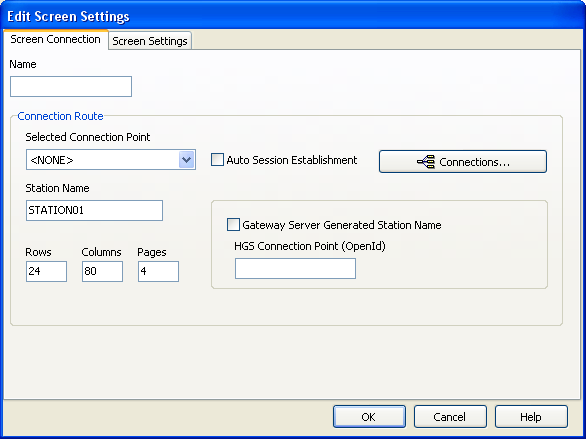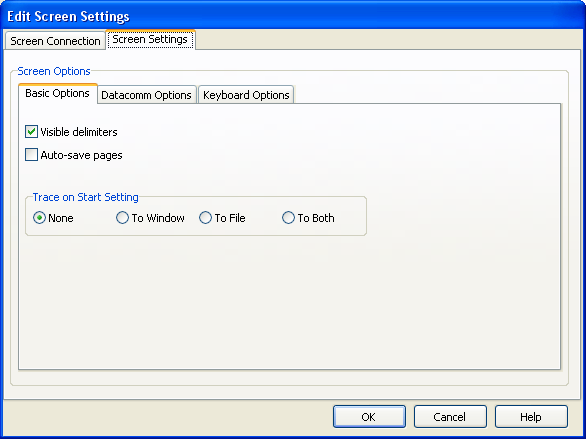Adding T27 screens
The Edit Screen Settings dialog is used to add and edit the T27 configuration screens. It contains the Screen Connection and Screen Settings tabs.
Screen Connection tab
The Screen Connection tab defines the screen name and connection route information.

Figure 2: Edit Screen Settings dialog

Name
Type a name for the new screen. Up to 24 screens can be configured.
Connection Route
Set the following options:
| • | Selected Connection Point: Select a connection point to be used when the screen is opened. The first time this screen is accessed, the only available option is <NONE>. You must configure your host connections by clicking Connections. Refer to Configure host connections for more information.
|
| • | Auto Session Establishment: Enables auto session establishment. |
| • | Station Name: Type a name for station. |
| • | Rows: Type the number of rows allowed in the screen. |
| • | Columns: Type the number of columns allowed in the screen. |
| • | Pages: Type the number of pages. |
| • | Gateway Server Generated Station Name: Enables the Gateway server generated station name. |
| • | HGS Connection Point (OpenId): Type the open ID of the Gateway server. |
Screen Settings tab
The Screen Settings tab contains the Basic Options, Datacomm Options, and Keyboard Options tabs.


Basic Options tab
Visible delimiters
If enabled, field delimiters are displayed when in forms mode. Refer to Toggle Forms located in the Datacomm Options tab below.
Auto-save pages
If enabled, the contents of all pages in an environment are saved to disk when the environment is closed. The pages are then
restored when the environment is reopened.
Note
As a result of this action, page one is overwritten on start up.
Trace on Start Settings
The controls in this group determine what trace activity is to take place, if any, when the screen is first opened. Select
one of the following options:
| • | None: No tracing activity takes place. |
| • | To Window: A separate trace window opens to display the trace. |
| • | To File: The Emulator Trace File dialog opens when the screen is opened. In the Emulator Trace File dialog, type the text file name for the trace file. The trace file is normally stored in C:\Documents and Settings\username\Local Settings\Temp directory and has a .txt extension. |
| • | To Both: Traces to both a window and file. |
Datacomm Options tab
The Datacomm Options tab governs communications between the host and PC. Multiple options can be selected.
Transmit Full Page in Forms Mode
The full page is transmitted to the host when in forms mode (see Toggle Forms below). If this box is not checked, only the unprotected data from the home position to the cursor will be transmitted.
Convert CR to CRLF
A line feed character is appended to any carriage return character sent by the host application.
Convert LF to LFCR
A carriage return character is appended to any line feed character sent by the host application.
SOH Clears Screen
The screen is cleared upon receipt of an SOH character.
SOH Clears Forms Mode
Forms mode is terminated upon receipt of an SOH character.
Position to Left of UPF
The effect of the Home function places the text cursor to the first character position of a right justified, unprotected field;
otherwise, the cursor will be moved to the data entry position, or right-most position of the field.
Transmit Line at a Time
Forces the normal Transmit to act like the Transmit Line key.
Hold in RCV Mode
The screens remain in receive mode after getting a message from the host application (see Stay in RCV below).
Beep Alarm Sound
Turns an audible beep on. If this box is not checked, no audible sound is heard.
SO/SI Translation
Enables SO/SI (7-bit to 8-bit/8-bit to 7-bit) character translation on data transmitted to the host.
SO/SI Extended Characters
Enables SO/SI (7-bit-to-8-bit/8-bit-to-7-bit) character translation on data received from the host. This option is not required
if the host transmission is prefixed by ESC SO sequences.
DC2 Function
The option in this group instruct BlueZone T27 how to interpret the DC2 character when received from the host:
| • | Toggle Forms: Toggles the to/from forms mode upon receipt of the DC2 character. |
| • | Advance Page: Stay in the current mode (forms or no-forms) and advance the DataComm pointer one position to the right upon receipt of the DC2 character. |
DC1 Function
The options in this group instruct BlueZone T27 how to interpret the DC1 character when received from the host. These options
are mutually exclusive:
| • | Stay in RCV: Choose this option to keep the screens in receive mode upon receipt of a DC1 character. This option nullifies the Hold in RCV option (see above). |
| • | Line Clear: Choose this option to clear the line upon receipt of the DC1 character. |
Alternate Delimiters
In this group, type the alternate delimiters sent by the host application. Alternate delimiters are only required when in
forms mode:
| • | Left Character (hex): Type the hex character sent and interpreted as the beginning delimiter of left-justified unprotected fields. The default is the US character (1F). |
| • | Right Character (hex): Type the hex character sent and interpreted as the ending field delimiter. The default is the RS character (1E). |
Keyboard Options tab
The Keyboard Options tab governs keyboard actions. Multiple options can be selected.
Note
There are additional keyboard options located on the Miscellaneous tab in the Keyboard Options dialog.
Refer to Keyboard Options dialog for information on the additional keyboard options.
Start in UPPERCASE Mode
The keyboard automatically starts in UPPERCASE mode. Enabling this feature has the effect of turning on the Caps Lock key
when the BlueZone T27 session is launched. The end user can turn off Caps Lock by pressing the Caps Lock key. This feature
is useful when your host requires that the entire log on process be in uppercase characters but, you still want the option
to revert to standard case at any time.
Force UPPERCASE Only
Converts lowercase characters that are typed to their uppercase equivalents. The Shift Key will reverse the effect of Force UPPERCASE Only while it is being held down. In other words, if the Force UPPERCASE Only check box is enabled, and the Shift key is held down while pressing a letter key, the input will be lower case.
Add LF to Return
A line feed character is appended when the Carriage Return key (Enter) is pressed. If this box is not checked, only the carriage
return is issued.
Automatic Field Advance
Advances the cursor automatically to the next field when the current field becomes full.
Right Justified is Numeric-Only
Only the characters 0-9, space, period (.), and comma (,) will be allowed in a right-justified field. If the box is not checked,
any character will be accepted.
Insert Space in Insert Mode
A space is inserted whenever the Insert key is pressed.
Specify Sends Page Number
The page number (in addition to the normal column and row designating the cursor position) is sent the host application when
the Specify key is pressed.
Specify Sends Hex
The cursor position (column and row) is sent in hexadecimal when the Specify key is pressed. If this box is not checked,
the cursor position is reported in ASCII.
Destructive Backspace Key
Erases characters as the Backspace key is pressed.
Ignore Programmed Macros
The emulator ignores any host or manually programmed T27 macro keys. Checking this box does not prevent Enable scripts related
to action keys from running. The box is checked by default.
CR acts like TAB
Makes the Carriage Return key (Enter) behave like the Tab key.
Tab Stops
Type the column positions (separated by commas) of the tab stops. The default is 1,9,17,25,33,41,49,57.
Character Translation Table
Select a country that most closely matches your keyboard requirements.
| • | Edit Translation Tables: Opens the Character Translation dialog. This dialog provides the ability to select and edit character translation sets for specific countries. |
Refer to Configuring character translation for more detailed information.
Clear Function
This group specifies what action occurs when the Clear key is pressed. These options are mutually exclusive.
| • | Clear Entire Screen: Clears the entire screen. |
| • | Clear Fields Only: Clears all unprotected fields. |